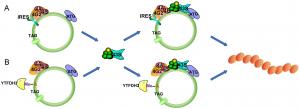Unlocking the Hidden Proteome: The Role of Coding Circular RNA in Cancer
SHANNON, CLARE, IRELAND, March 7, 2025 /EINPresswire.com/ -- A new review article highlights the transformative role of circular RNA (circRNA) in cancer, revealing its potential as both a key player in tumor biology and a promising avenue for future therapies. Once thought to be noncoding RNA, circRNA has now been shown to encode functional proteins, challenging conventional RNA biology and opening up novel therapeutic possibilities.
Unlike traditional messenger RNA, circRNAs form a continuous loop, lacking the typical 5' cap and 3' tail. This unique structure was originally believed to preclude them from protein translation. However, recent discoveries demonstrate that specific internal ribosome entry sites (IRES) and N6-methyladenosine (m6A) modifications enable circRNAs to undergo cap-independent translation. The resulting proteins influence a range of cellular processes, including those linked to cancer progression and suppression.
Emerging evidence underscores the significance of circRNA-encoded proteins in multiple types of cancer, including glioblastoma, breast cancer, gastric cancer, liver cancer, and colorectal cancer. These proteins interact with critical signaling pathways, such as PI3K/Akt, Wnt/β-catenin, and TGF-β/Smad, influencing cell proliferation, migration, and apoptosis. In glioblastoma, for instance, circRNA-derived proteins contribute to tumorigenicity, while in colorectal cancer, they regulate metabolic processes that drive malignancy.
Beyond their role in cancer progression, translatable circRNAs are poised to redefine RNA-based therapeutics. Their stability and potential for long-lasting protein expression make them promising candidates for protein replacement therapies, vaccines, and targeted drug development. Advances in bioengineering have further enhanced circRNA synthesis, enabling more efficient protein production and laying the foundation for circRNA-based immunotherapies. These innovations could lead to highly potent treatments with improved delivery mechanisms and greater precision in targeting malignant cells.
Despite their vast potential, significant challenges remain in understanding the regulatory mechanisms governing circRNA translation. Key questions include how these proteins achieve tissue-specific functions and how circRNA synthesis can be optimized for clinical applications. Current research aims to refine the techniques used to design and manufacture artificial circRNAs, ensuring their efficacy and safety in medical treatments.
This new understanding of circRNAs as hidden protein sources represents a major shift in molecular biology and oncology. By further exploring their coding potential, researchers and clinicians may unlock new ways to detect, treat, and ultimately prevent cancer.
Funding Information:
National Natural Science Foundation of China 81802406
Shandong Provincial Natural Science Foundation of China ZR2021MH045
Shandong Provincial Natural Science Foundation of China ZR2020LZL009
Shandong Provincial Natural Science Foundation of China ZR2019BH061
Shandong Provincial Natural Science Foundation of China ZR2021MH225
Special Funds for Scientific Research on Breast Diseases of Shandong Medical Association of China YXH2021ZX058
# # # # #
Genes & Diseases publishes rigorously peer-reviewed and high quality original articles and authoritative reviews that focus on the molecular bases of human diseases. Emphasis is placed on hypothesis-driven, mechanistic studies relevant to pathogenesis and/or experimental therapeutics of human diseases. The journal has worldwide authorship, and a broad scope in basic and translational biomedical research of molecular biology, molecular genetics, and cell biology, including but not limited to cell proliferation and apoptosis, signal transduction, stem cell biology, developmental biology, gene regulation and epigenetics, cancer biology, immunity and infection, neuroscience, disease-specific animal models, gene and cell-based therapies, and regenerative medicine.
Scopus CiteScore: 7.3
Impact Factor: 6.9
# # # # # #
More information: https://www.keaipublishing.com/en/journals/genes-and-diseases/
Editorial Board: https://www.keaipublishing.com/en/journals/genes-and-diseases/editorial-board/
All issues and articles in press are available online in ScienceDirect (https://www.sciencedirect.com/journal/genes-and-diseases ).
Submissions to Genes & Disease may be made using Editorial Manager (https://www.editorialmanager.com/gendis/default.aspx ).
Print ISSN: 2352-4820
eISSN: 2352-3042
CN: 50-1221/R
Contact Us: editor@genesndiseases.com
X (formerly Twitter): @GenesNDiseases (https://x.com/GenesNDiseases )
# # # # # #
Reference
Yuan Lin, Yawen Wang, Lixin Li, Kai Zhang, Coding circular RNA in human cancer, Genes & Diseases,
Volume 12, Issue 3, 2025, 101347, https://doi.org/10.1016/j.gendis.2024.101347
Genes & Diseases Editorial Office
Genes & Diseases
+ +86 23 6571 4691
editor@genesndiseases.com
Legal Disclaimer:
EIN Presswire provides this news content "as is" without warranty of any kind. We do not accept any responsibility or liability for the accuracy, content, images, videos, licenses, completeness, legality, or reliability of the information contained in this article. If you have any complaints or copyright issues related to this article, kindly contact the author above.


